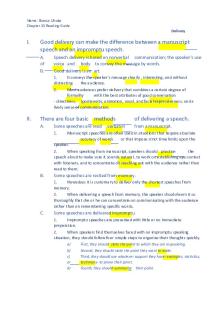CFA lvl 1 - Reading 13 PDF

| Title | CFA lvl 1 - Reading 13 |
|---|---|
| Author | Dorian Gachet |
| Course | Quantitative Methods |
| Institution | NEOMA Business School |
| Pages | 1 |
| File Size | 71.7 KB |
| File Type | |
| Total Downloads | 55 |
| Total Views | 171 |
Summary
Download CFA lvl 1 - Reading 13 PDF
Description
Quantitative Methods Reading 13: Technical Analysis Technical Analysis - Technical analysis is the study of collective market sentiment - It’s based on the idea that prices are determined by the interaction of supply and demand - A key assumption of technical analysis is that market prices reflect both rational and irrational investor behavior - This assumption implies that the efficient markets hypothesis does not hold - Technical analysts primarily use charts of price and volume to analyze asset prices and overall market movement - The time interval chosen reflects the trading horizon of interest to the analyst - Line charts: show closing prices for each period as a continuous line - Bar charts: add the high and low prices for each trading period and often include the opening price as well - Candlestick charts use the same data as bar charts but display a box bounded by the opening and closing prices - Point-and-figure charts are helpful in identifying changes in the direction of price movements Trend, support, resistance lines and change in polarity - A market is said to be in an uptrend if prices are consistently reaching higher highs and retracing to higher lows (et inversement pour un downtrend) - Drawing a trendline on a chart can help to identify whether a trend is continuing or reversing - At a support level, buying is expected to emerge that prevents further price decreases - At a resistance level, selling is expected to emerge that prevents further price increases - Support and resistance levels frequently appear at psychologically important prices such as round-number prices or historical highs and lows - Change in polarity: this refers to a belief that breached resistance levels become support levels and that breached support levels become resistance levels - Reversal patterns occur when a trend approaches a range of prices but fails to continue beyond that range. A well-known example is the head-and-shoulders pattern...
Similar Free PDFs

CFA lvl 1 - Reading 13
- 1 Pages

CFA lvl 1 - Reading 58
- 5 Pages

CFA lvl 1 - Reading 16
- 5 Pages

CFA lvl 1 - Reading18
- 5 Pages

Chapter 13 Active Reading
- 8 Pages

Chapter 13 Reading Guide
- 4 Pages

Chapter 13 Guided Reading
- 5 Pages

Wk 7 - corporate lvl strategy
- 4 Pages

CFA Standards 5A - CFA HANDBOOK
- 14 Pages
Popular Institutions
- Tinajero National High School - Annex
- Politeknik Caltex Riau
- Yokohama City University
- SGT University
- University of Al-Qadisiyah
- Divine Word College of Vigan
- Techniek College Rotterdam
- Universidade de Santiago
- Universiti Teknologi MARA Cawangan Johor Kampus Pasir Gudang
- Poltekkes Kemenkes Yogyakarta
- Baguio City National High School
- Colegio san marcos
- preparatoria uno
- Centro de Bachillerato Tecnológico Industrial y de Servicios No. 107
- Dalian Maritime University
- Quang Trung Secondary School
- Colegio Tecnológico en Informática
- Corporación Regional de Educación Superior
- Grupo CEDVA
- Dar Al Uloom University
- Centro de Estudios Preuniversitarios de la Universidad Nacional de Ingeniería
- 上智大学
- Aakash International School, Nuna Majara
- San Felipe Neri Catholic School
- Kang Chiao International School - New Taipei City
- Misamis Occidental National High School
- Institución Educativa Escuela Normal Juan Ladrilleros
- Kolehiyo ng Pantukan
- Batanes State College
- Instituto Continental
- Sekolah Menengah Kejuruan Kesehatan Kaltara (Tarakan)
- Colegio de La Inmaculada Concepcion - Cebu






